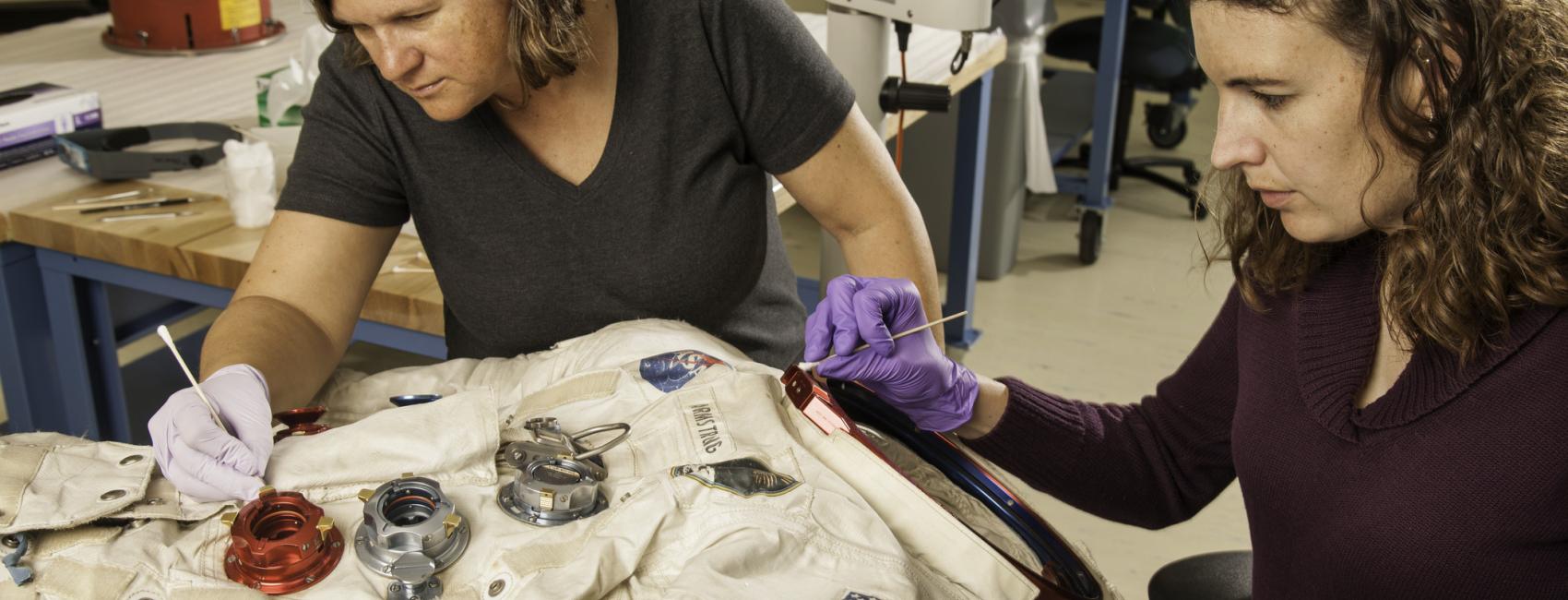
Apr 08, 2019
By Beth Wilson, Host, STEM in 30
Anyone will tell you that nothing in television happens overnight. Schedules, budgets, scripts, guests, video shoots—these things take months and sometimes even years to produce. I’ve learned this firsthand during my time as a host of the Museum’s middle school webcast series STEM in 30. However, we have to start somewhere and the STEM in 30 team usually starts from stupid, and by stupid we mean what’s the most outlandish way we can cover a topic? For example, last year we developed a show on Naval Aviation and we ended up spending three days filming on the USS Dwight D. Eisenhower. Most of the ideas bubble up from ordinary events in our daily lives. Take the April 2019 show, for example.
It all started in May 2017, the National Oceanic and Atmospheric Administration (NOAA) and the United States Air Force 53rd Weather Reconnaissance Squadron arrived at Reagan National Airport and their aircraft were on display to the public. These specialized planes are commonly referred to as Hurricane Hunters. STEM in 30 producer Jon Boyette was at the public viewing, and thought, “This is awesome! It must be both terrifying and exhilarating to intentionally fly into a hurricane.” As an Air Force Major wrapped up the tour of his modified WC-130J airplane, he began to field questions. At this point Jon asked, “Do you ever fly media into the storm?” “All the time,” the major replied. And “start from stupid” had begun.
C-130 flown by the Hurricane Hunters.
By spring 2017, STEM in 30 had already scheduled and produced much of the upcoming fall season and we just couldn’t make a Hurricane Hunter show happen. However there was plenty of time to get the Air Force on board for the 2018 hurricane season, and by the time the season started the Air Force was ready to fly us in a storm. On September 9 we got the green light. Hurricane Florence was developing into an ominous storm, and STEM in 30 had 36 hours to get someone to Savannah, Georgia, to fly into it.
After navigating government approvals and paperwork, co-host Marty Kelsey made it to Georgia, got to the hotel for a few hours of sleep, and reported to the base at midnight on September 11. Once there, the members of the media had a safety briefing and were taken to see their ride—an enormous C-130 airplane. The groups boarded and the plane started rumbling down the runway. Once in the air, the wait began. There was at least six hours of flying time before they reached Hurricane Florence.
Flying into a hurricane begins by seeing heavy clouds in the distance. Then, as you start flying through bands of the storm, there are some bumps but nothing too crazy. As the plane got closer to the eye, Marty could barely see anything out the windows and the ride was getting bumpy. The media public affairs officer called a couple of the groups up to the cockpit to film and talk to the pilots as they were about to fly through the eye of a Category 4 hurricane. The pilot told the group to hold on; the plane was about the punch through the eye wall. After a few significant bumps, there was suddenly perfectly blue clear skies above, white caps on the ocean and clouds all around. Once in the eye, the plane made several turns to drop the storm tracking sonds (storm tracking devices), and then after a few larger bumps, the plane escaped the eye and headed back to Georgia.
While flying a plane through a hurricane is awesome, it's hard to make an engaging television show with just that footage. It makes for a great segment, but the show needed an expert who could address why the hurricane hunters go into the storm and provide context as to what exactly a hurricane is. That's when “start from stupid” again kicked into high gear.
As ABC’s Chief Meteorologist, Ginger Zee delivers the weather to the nation each day on Good Morning America, but it was through her Helicity Dunlap books for middle school students that Jon learned about her passion for science education. So, after months of emails, meetings, and countless production decisions, the STEM in 30 crew was on the train from DC to New York to work with Ginger Zee.
But that’s not all that was planned. Since I wasn’t able to take a ride with the Hurricane Hunters, I was volunteered to stand in 100 MPH winds produced in a wind tunnel at the Liberty Science Center’s Skyscraper! Achievement and Impact exhibition. The final show will also include some not-so-stupid experiments hosted by museum educator Shauna Edson, and we’ll have a Facebook Live Mission Debrief with Capital Weather Gang meteorologist Jason Samenow. We hope you’ll check out STEM in 30, and remember there that are no stupid questions; in fact, those may be the questions that you learn the most from.

We rely on the generous support of donors, sponsors, members, and other benefactors to share the history and impact of aviation and spaceflight, educate the public, and inspire future generations. With your help, we can continue to preserve and safeguard the world’s most comprehensive collection of artifacts representing the great achievements of flight and space exploration.
We rely on the generous support of donors, sponsors, members, and other benefactors to share the history and impact of aviation and spaceflight, educate the public, and inspire future generations. With your help, we can continue to preserve and safeguard the world’s most comprehensive collection of artifacts representing the great achievements of flight and space exploration.